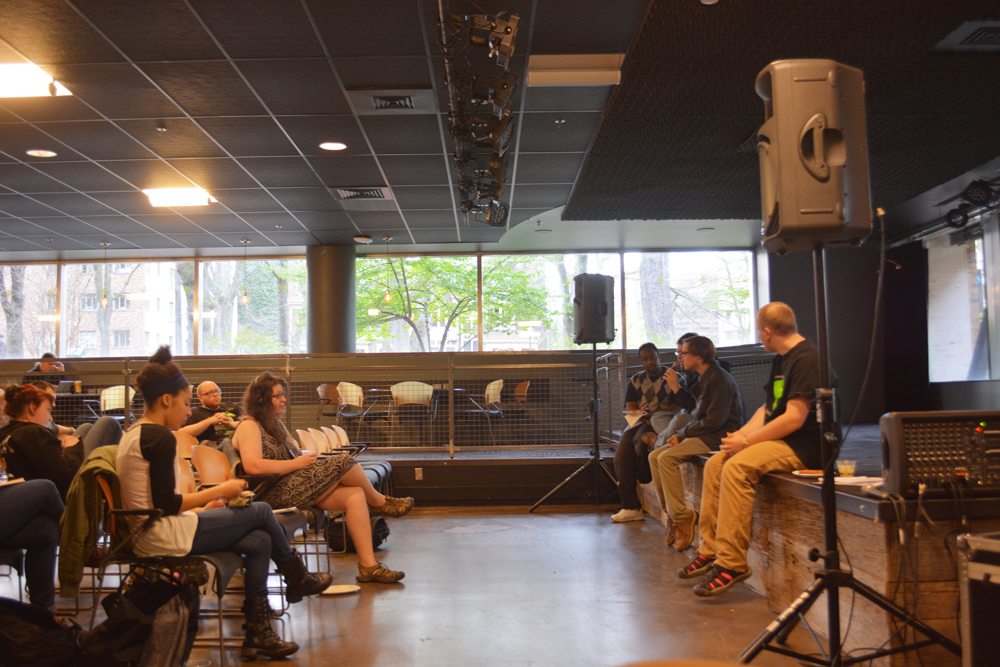A group of legislators and university administrators toured two buildings on campus Wednesday, inspecting a flooded basement, cracking, asbestos-laden roofs and visiting foul-smelling chemistry labs. Six members of the Subcommittee on Education of the Joint Committee on Ways and Means are considering Senate Bill 5516, which would give Oregon’s universities $172 million to renovate and improve facilities during the 2007-09 biennium.
Legislators examine buildings
A group of legislators and university administrators toured two buildings on campus Wednesday, inspecting a flooded basement, cracking, asbestos-laden roofs and visiting foul-smelling chemistry labs.
Six members of the Subcommittee on Education of the Joint Committee on Ways and Means are considering Senate Bill 5516, which would give Oregon’s universities $172 million to renovate and improve facilities during the 2007-09 biennium. Administrators from Portland State, representatives from the Oregon University System (OUS) and student body President Courtney Morse joined the legislators on the tour.
“We’re going to show you some horror stories,” said Lindsay Desrochers, vice president for administration and finance, to the six legislators. “We’d like to show you a lot more, but we’ve only got a half an hour and these are the most important.”
Bob Simonton, OUS director of capitol construction, was pleased that the committee visited one of the universities that could benefit.
“Normally we just get to convey this kind of information to the legislators without them witnessing it firsthand,” Simonton said during the tour, which started with a dusty climb up a secret stairwell to the roof of Lincoln Hall.
State Sen. Richard Devlin, D-Tualatin, a member of the committee, recalled his days as a PSU student while atop the mossy, deteriorating patchwork of roof.
“I didn’t have any classes in this building,” Devlin said. “We usually met in Cramer or Neuberger, which haven’t changed much. I think they’re still using the same desks over there.”
Robyn Pierce, the Portland State director of facilities, next brought the group down to Lincoln’s basement, where an October leak from Southwest Broadway caused $900,000 in damage, filling the area with three feet of water.
“It could have been worse,” Simonton said. “If it had been caught later, the damage would have been in the millions.”
Water is still dripping from the ceiling in two places, pooling under shelves of equipment.
Pierce showed Rep. Bob Jensen, R-Pendleton, a piece of decayed and blocked pipe that had been removed from the building two weeks ago.
“This is generally how occluded they get,” Pierce said. “It just erodes to the point that the water can’t get through.”
Pierce said that the plumbing for the building needs to be completely replaced.
“Oh my God, look at this,” said committee Chair Larry Galizio, D-Tigard, to Pierce when he saw the pipe. “Are you trying to tell us something?”
The Senate bill would put $29 million toward repairing Lincoln Hall, which is close to condemnation and is currently under a conditional use permit with the city of Portland. Built in 1911, Lincoln Hall was the first building the university occupied when it relocated to its current location in 1953. The Portland school district sold the building when it decided that fixing it would be too costly.
About $26 million of the bill would fund part of a $48.2 million overhaul of Science Building 2, which would include new plumbing, ventilation and a new electrical system.
The need for a new ventilation system was immediately apparent as the group made its way toward a chemistry lab in Science Building 2.
Dean of Liberal Arts and Sciences Marvin Kaiser pointed out the foul odor of the room and the lab’s four hoods.
“This is a big issue in the general chemistry labs,” Kaiser said. “Some don’t even have hoods. You can smell that we don’t have sufficient air filtration form the HVAC system.”
Kaiser told the group that classes are held in the building seven days a week, while the enrollment of students in biology and chemistry continues to grow.
An extra $19 million could be spent on a new hazardous waste facility, which would be located in Science Building 2. The current facility cannot house the volume of waste and is in violation of fire code.
Portland State’s facilities and buildings would require a total of $192 million to catch up on maintenance put off in the past.





